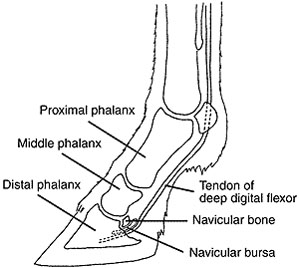| Home Medical Index Farrier Wisdom | First Posted: Mar 5, 2009 Updated:Jan 21, 2020 | |
Navicular Disease aka Navicular Syndromeby Debora JohnsonFirocoxib Dose for Navicular Pain and Osteoarthritis Established  Drawing of Internal Part of Horse's Foot Newest Update: Podoatrochlosis: Navicular is No Longer the End of the Road for Horses Update: "...What's in a Name? Wally Liberman, DVM, of Panorama Equine Medical and Surgical Center, in Redding, California, focuses on diagnosing and treating lameness-in particular, hoof problems. 'The evolution of the concept of navicular has changed considerably because of our increased imaging capability through digital radiography, ultrasound, and magnetic resonance imaging (MRI),' he says. 'MRI as the gold standard for diagnosis has allowed us to appreciate how often things are going on in the zone that we refer to as navicular that actually involve multiple anatomical locations.' Today, the descriptor navicular disease is misleading, inaccurate, and best discarded. 'The term caudal (toward the rear) heel pain is similarly misleading,' says Liberman. 'This syndrome is not an external hoof capsule disease, which could be part of caudal heel pain; it centers within structures that make up the podotrochlear apparatus within the hoof.' Infographic: Navicular Disease Update: "Horses with chronic navicular pain might benefit from analgesic (pain-relieving) injections in the navicular bursa, a tiny space nestled between delicate structures within the hoof. But getting a needle into that space can be tricky...." New Navicular Bursa Injection Technique Validated More appropriate names for navicular disease, he says, are podotrochleitis or podotrochlosis, both of which are correct anatomical descriptions that include the following structures within the podotrochlear apparatus (see illustration on the next page), any of which have the potential to be diseased:
'It is not uncommon to find not just one but, rather, a multitude of those tissue masses involved in what people have historically referred to as navicular disease or syndrome,' he says. 'MRI has allowed us to understand this and to diagnose which tissues are involved.'"... The New Navicular Paradigm Navicular disease is essentially a chronic degenerative condition of the navicular bursa and navicular bone that involves damage to the flexor surface of the bone and the overlying deep digital flexor tendon with osteophyte formation on the lateral and proximal borders of the bone. It is a syndrome with a complex pathogenesis rather than a specific disease entity. It is one of the most common causes of chronic forelimb lameness in horses but is essentially unknown in ponies and donkeys. Palmar foot pain is a modern term for navicular syndrome. Reference will also be made to phrases such as navicular region pain and caudal heel pain to describe horses with chronic forelimb lameness caused by pain stemming from the navicular bone and related structures.
Treatment Navicular disease can be treated but rarely cured.
The following links have comprehensive articles on navicular in horses: The New Navicular ParadigmNavicular Disease: Research Needed to Better Understand Navicular Syndrome in Horses/Robert C. McClure Department of Veterinary Anatomy, School of Veterinary Medicine Navicular Bursography Navicular Disease in Horses James M. Casey, D.V.M, M.S., Equine Sports Medicine, Dentistry, & Surgery Palmar Foot/Heel Pain in Horses Cases that Mimic Navicular Disease Microstructural Alterations and Navicular Bone Degeneration |